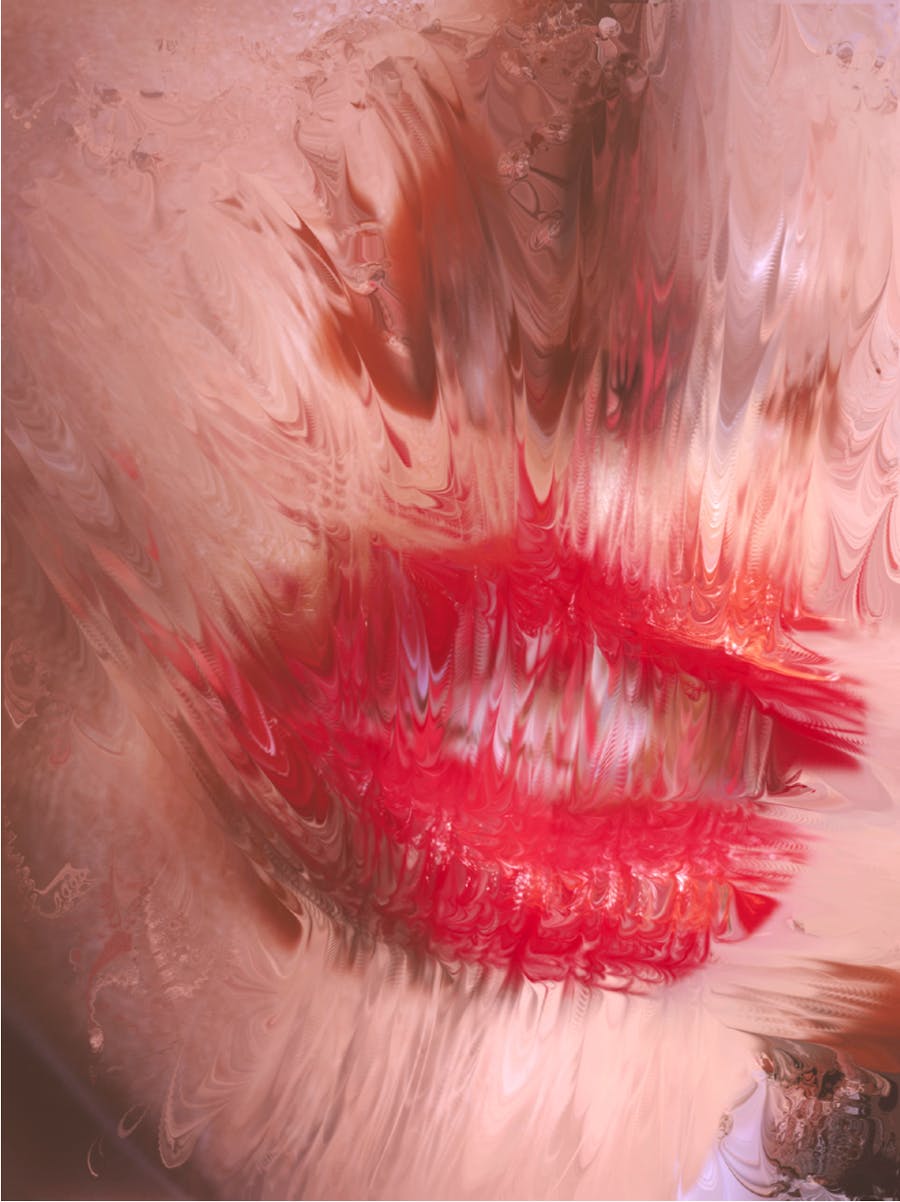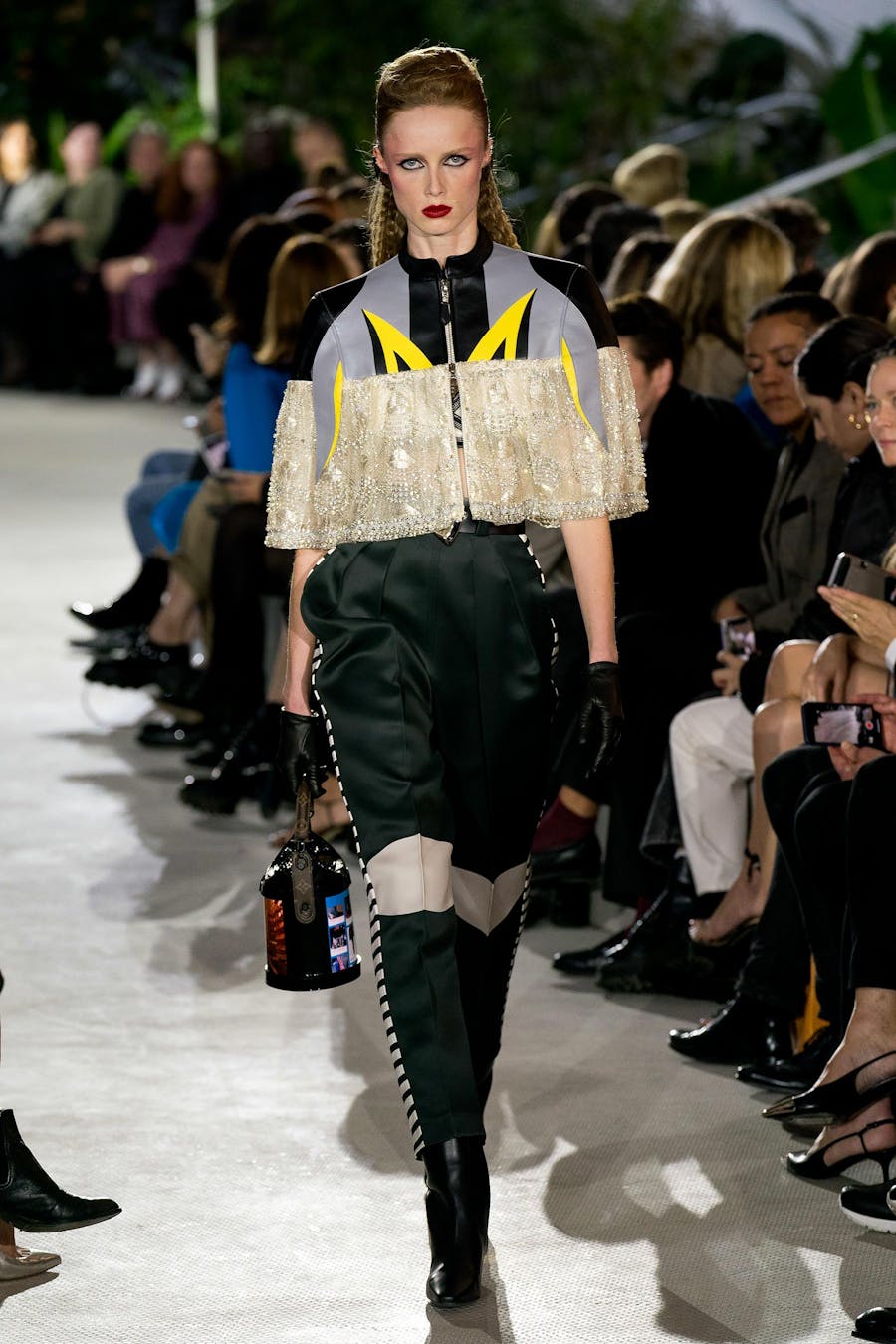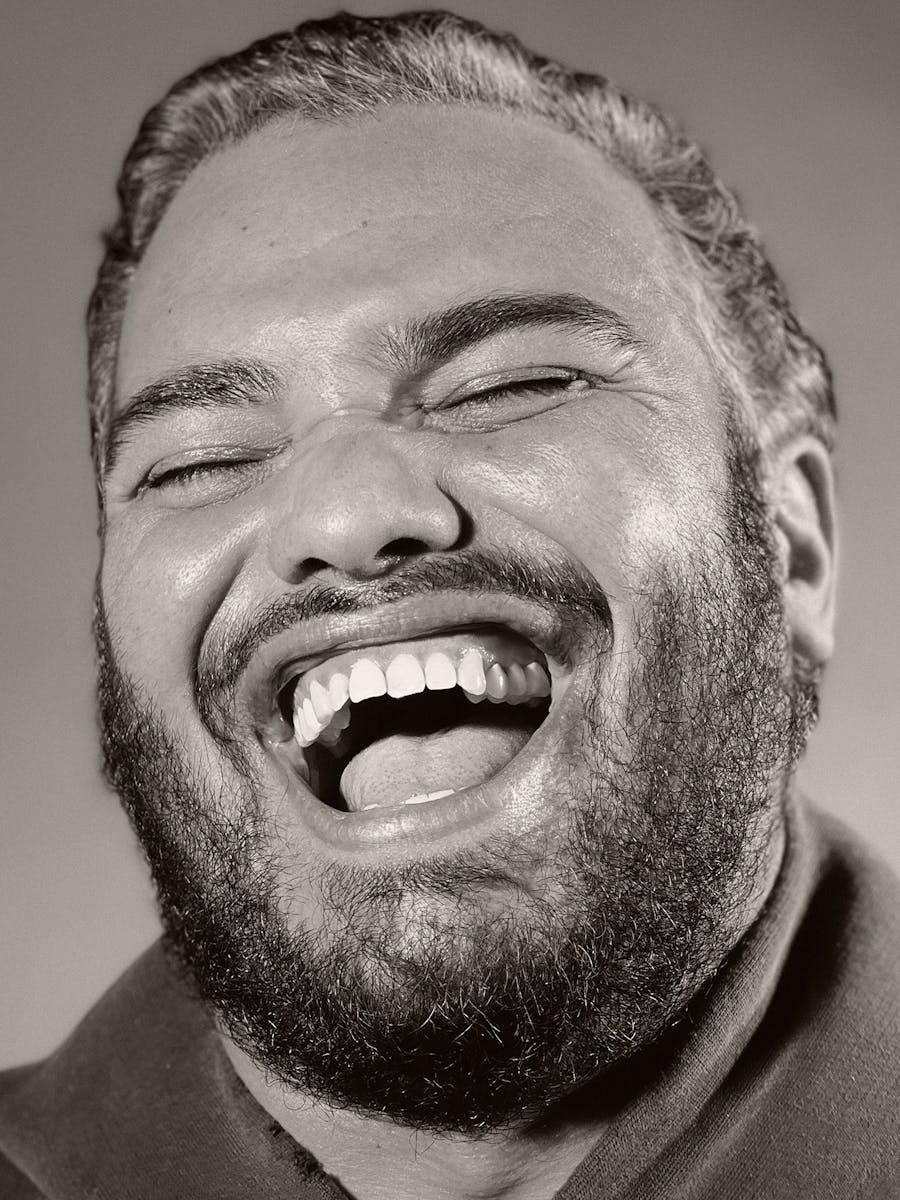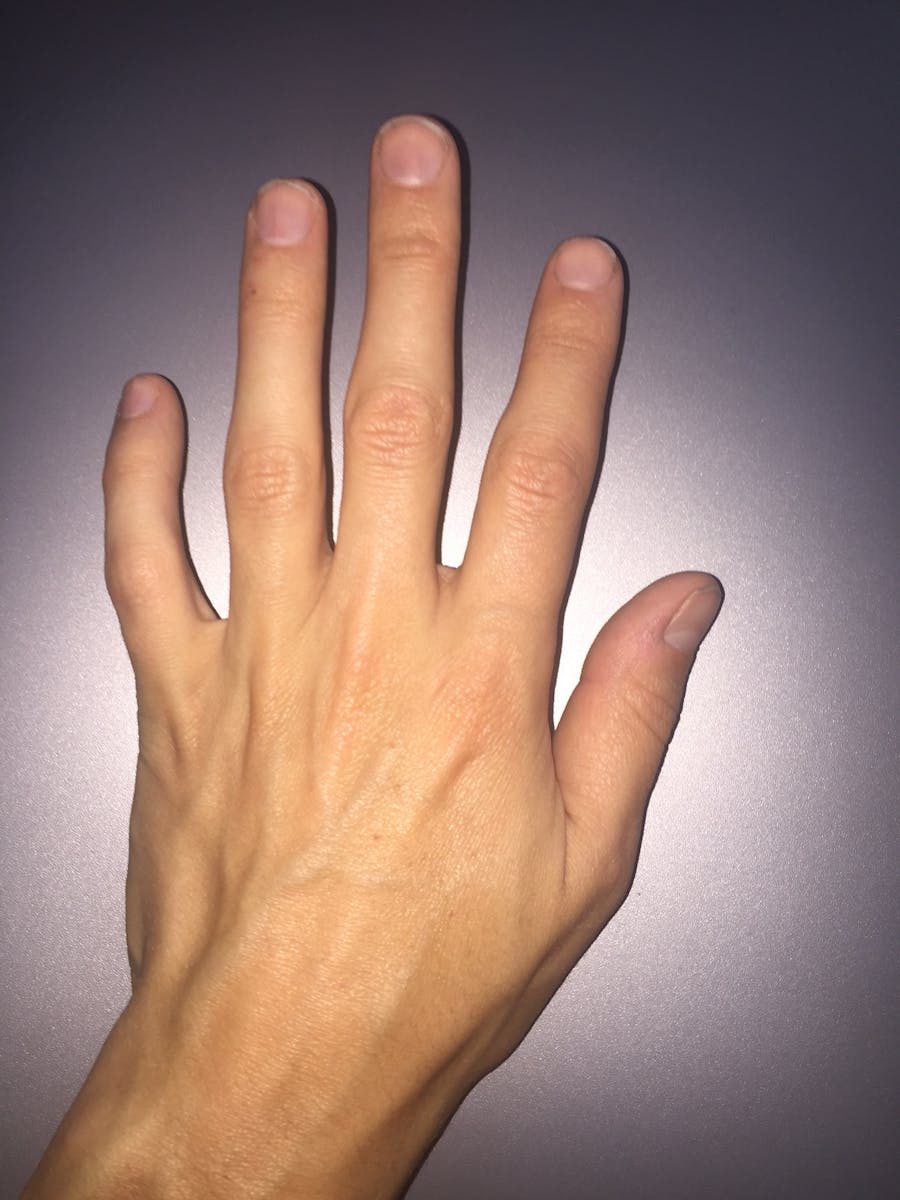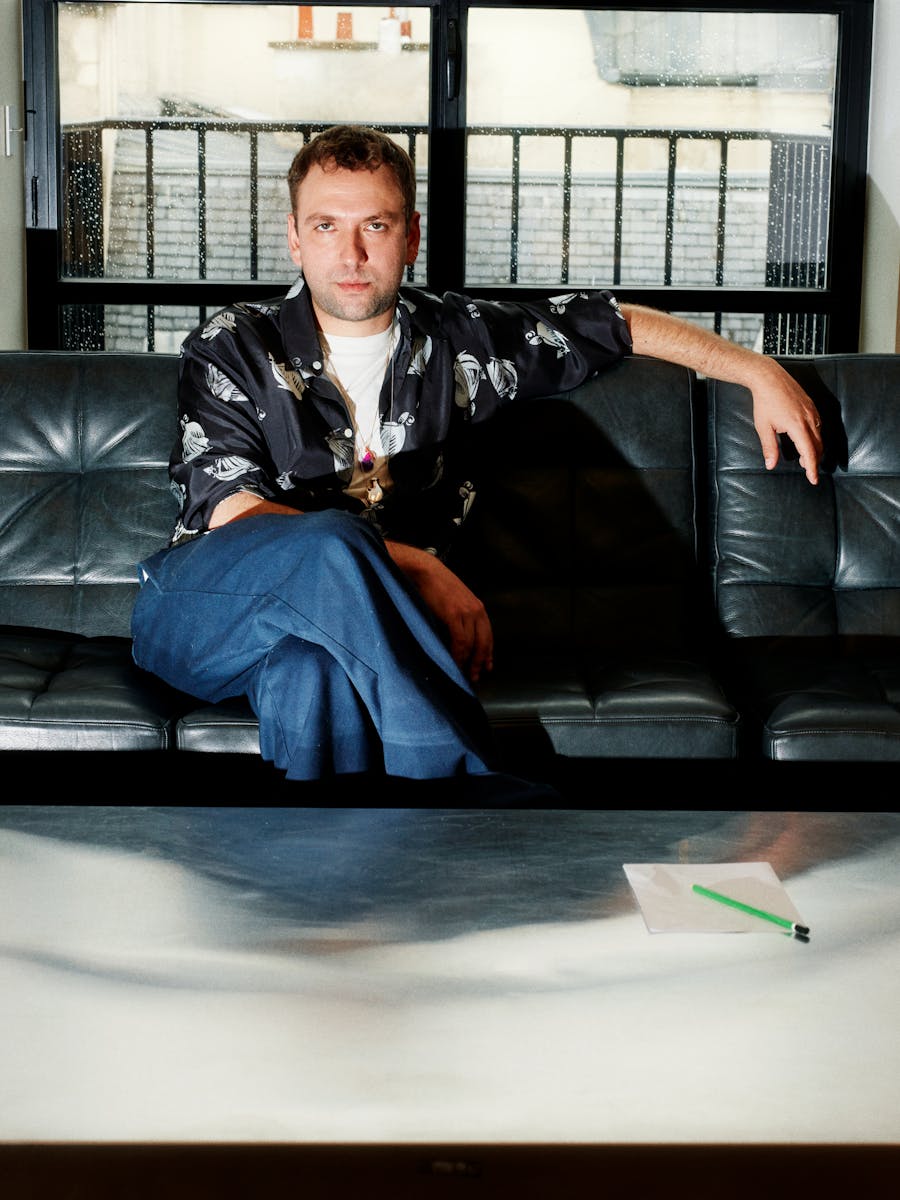To what extent is it necessary, this being called Guru, or rather this shadow, this indelible memory whose presence-absence is legible in conscious and unconscious actions? A being who resembles nothing, who seems buried in memory, who is here, seen over and over again, who has taken a form so precise that we feel the need to rid ourselves of it. Who are the gurus of young designers? Are they constructing them or deconstructing them? Are they faithful to them? What does it tell us about fashion today? Charlotte Knowles, Duran Lantink, Rok Hwang (Rokh) and Christa Bösch and Cosima Gadient (Ottolinger) do not align themselves with this illusory tradition of the guru. They don’t brandish the discourse of the avant-garde, which would obscure their creativity, their derisive sensibility, their distance from the society of the image and their consciousness of the current business of fashion. History moves on and the framed photos of idols gather dust. The system of fashion has theorized itself, reflecting on its past to imagine new forms of modernity. Young designers are here to propose narratives rather than impose them. Thus they feel sentimental about idols rather than tormented by them. Karl Lagerfeld has gone – the guru who had the intelligence and presence of mind to accept playing such a difficult a role for the public – and a new fashion scene is taking shape and discussing its own relationship with the figure of the guru.
ROKH
Rok Hwang
“Every thing we do has repercussions. You have to be responsible for your actions. At least, that’s how I see it. You have to assume”, says Rok Hwang. Know thyself – a phrase Socrates saw when he visited the Temple of Delphi, and which fascinated him so much that it became a keystone of his philosophy. Since then, these same words have obsessed philosophers, becoming the object of debates between Nietzsche and Kierkegaard. “Know thyself” is the sort of guru axiom, veiled in wisdom, that we find in the words of Rok Hwang. He launched Rok in 2016 and just two years later he won the LVMH special prize. Does he owe his success to a guru? It’s tempting to think so, and not hard to think of candidates. On the list would be Louise Wilson, Phoebe Philo and Sophie Brocart (current CEO of Patou, LVMH): a sort of holy trinity of fashion whose presence in this modern epic would poetically echo the fairy tales and coming-of-age stories of European literature. “I think I’m realistic, not superstitious. ”A twist in the tale? Rok as anti-hero? He laughs: “I’d never really thought about a guru until now. So maybe that makes me boring and normal.” However, every little ripple of laughter reveals a sensitive pragmatism: “Christian Dior consulted oracles?! Gosh, I’m the opposite of Dior! I believe in actions, in decisions. I’m not afraid of what can happen in life. ”There he is, our hero. It is with a philosophy of action implying self-knowledge that Rok makes his way in the world. A guru in disguise?
“Pragmatic. I conceive of things in a very pragmatic way. In life as well as in fashion I like to be realistic, to be in a quiet place. My life is based principally upon actions: that’s what I believe in. People help me, guide me, inspire me on this journey. Take my team for example – I love them with all my heart, they are friends, we talk a lot, we discuss ideas in the studio where openness is encouraged. Objections have to be voiced in order to create without taking a wrong turn, especially in fashion: the object of all our dreams. However, to create you mustn’t reduce the whole dream to a blank, to what it projects. Rather than artists, let’s talk about artisans. Of course creating womenswear collections brings me a lot of satisfaction, but for me it’s work like any other. It’s my reality, my profession: fashioning fantasy with rigour. Of course, it takes time to come to this conclusion, and help. When I was starting out, I inclined towards menswear. One of my teachers, Louise Wilson, opened my eyes. She got me into women’s fashion and convinced it would be perfect for me. When I listened to her I discovered all the possibilities of going down that road: materials, colours – all the elements I play with to enhance women’s beauty. In a sense, Louise Wilson liberated me. Working in menswear, it was impossible for me to explore extravagance: extravagance quickly becomes overkill. Two other women were also important. First, Phoebe Philo: she gave me advice which remains etched in my memory. She allowed me, professionally, to define my career. She opened my eyes to many things and broadened my understanding of women’s fashion. A true inspiration! With Sophie Brocart: what an intellect! What a mind! She got me started in business. She’s brought me so much and I can always turn to her for help. They are the three women with me on this journey. A trio, maybe that means something, but I don’t know what. There was nothing to suggest I was going to meet three such exceptional women. No premonitions. Maybe I’ll meet other people like that, guru-mentors on my way. I hope so, but I’m not expecting it. I don’t think it’s good to stay passive. I act, and I do so with a profound confidence in life and truth. I love this life, I love fashion, my routines, constructing myself in a calm space. To tell the truth, believing in acts and decisions is probably linked to the fact that I had a religious education. I do, in some way, believe in a god, but it is the effects of actions which matter. So you have to try and try again.”
OTTOLINGER
Christa Bösch & Cosima Gadient
Christa Bösch and Cosima Gadient are the two faces of the ready-to-wear label Ottolinger, founded in 2015. Since then, the Swiss duo have made deconstruction their signature: a process which suggests that beauty comes from chaos. A very modern fable, a metaphor of defiance in relation to a system which may have been lost in the rush to modernity. Necessarily, therefore, the game of deconstruction played by Christa and Cosima is a seductive one, whose rules you want to discover, whose tactics you want to understand. Positing a guru of some sort is like hacking their game: hypothesising the existence of a new member or of an overarching strategy. But certain games are for two players only. Christa and Cosima move their pieces together, in a dialogue which is their own. “I don’t know how we’d manage if we each had to set up a label ourselves” (they whisper to one another), “we’d be calling each other all the time” (silence, no doubt they are looking at each other), “It’s a really difficult question” Maybe they’re each other’s gurus? They laugh. “We’re really happy that we found each other. It’s really important to have someone with whom you can dialogue, with whom you can improve,” Christa says. So, it’s almost inappropriate to want to introduce a guru into this autonomous duo. They help each other, are responsive to each other, and thus they reformulate the idea of the guru in their own way. You sit next to them, you listen, you learn and you become the spectator of their dialogues, to intervene in which would be to lose the value of the lesson. Like the clothes they fashion, the two designers seem to be sewn together. I’m all in favour of this alchemy.
”To us the guru seems to be linked to the history of each individual. Choosing one is a decision that has to be made autonomously.
— As far as we’re concerned it’s not a word we use or think about. Of course, there are various people in our team who have had a significant impact on our work and who might fit the bill from an external point of view. We dialogue with them, we talk to them. They teach us things and above all, they’re honest with us. Exchange and honesty are essential. With that as the starting point, we can explore, in an informed way, the textures, colours and materials of the clothes.
— But we wouldn’t necessarily call these people gurus. The definition of guru comes from the hindu spiritual tradition. I prefer to translate ‘guru’ by the idea of someone external who teaches, from whom you learn something.
— Yes, a guru is someone from the outside who has a duty to be honest, someone from whom you learn. A person who encourages us and finds a way of our consolidating our projects whilst staying true to them.
— In our last collection, we were inspired by a story from Chinese science fiction: a trilogy by Liu Cixin. His vision of the world chimed with the story we wanted to tell. A magical world which invites exploration. In wanting to share his story, we experimented with new things ourselves. Mixtures of flannel, denim and sweaters. Always with that story in mind, a story which each woman who wears one of our pieces can embody.
— Stories have a very specific place in our creative process.
We don’t draw, so we have to choose them carefully.
— Yes, it always begins with a phrase, a discussion. We speak about it together several times and we think about how we can use that material to consolidate the original story and make it stronger.
— Taking an item of clothing, looking at it, seeing it transform is basically like watching a film about the life of this item of clothing. For us, it is in the reconstruction of the item of clothing that the beauty appears.
— We didn’t grow up in a place like Paris where there’s a strong fashion scene and an influential history. So fashion seemed far away. It was in the magazines. No doubt that explains our relationship to it and our creative process, in which experimenting with textiles and unexpected combinations comes easier to us. We allow ourselves to take liberties.
— Creating is allowing yourself to be guided by instinct: we always try to listen to each other, to trust each other’s instincts. So a guru? If it can help people, give them strength to be stronger, more confident, then it’s a good thing. But you mustn’t let it become a prison. For us, our parents had that kind of positive aura.
— We’re together, we found each other, we stick together. That must be a sign, no?”
An exchange of words begun by Cosima.
CHARLOTTE KNOWLES
Alexandre Arsenault & Charlotte Knowles
“Do you like fluidity?
— Yes, because fluidity is a means of conferring power....
— … Empowerment: our label must be a site of empowerment!
— To that end, we have to invent clothes in the same way a writer proposes words to invent a language – a language which everyone can feel free to complete...
— … With their own words. Finally a story is created in front of our very eyes.
— Yes! Charlotte Knowles is the story of a story which is created with us, almost in real time.”
Who was speaking? Alexandre or Charlotte? To be quite frank, their words intertwined and they finished each other’s sentences. Ideas fizz and fuse, making Alexandre Arsenault and Charlotte Knowles indissociable. They are united by an elaborate vision of what the fashion of tomorrow could be. Charlotte Knowles is more than a traditional label: it is a project whose consistency is nourished by inconsistencies, by the readings of those who wear the clothes. A veritable co-construction with the public. The entire project, ‘Charlotte Knowles’ elevated to the level of a concept, obsesses them, fascinates them, guides them, becoming their guru. “We always come back to it, we trust it, it’s the only thing we think about. We’re completely fascinated by the life of the label, its life as seen through the eyes of the public. That’s what guides us.”
Charlotte Knowles, or the story of a brand which has taken on the role of guru for its founders/developers: is that true artistic passion? Obsession with its creation? In the intermingled words of Alexandre and Charlotte, the concept of guru is redefined. From their two distinct voices a single, clear and unified language emerges. Over the course of the conversation, a third person comes into being: Charlotte Knowles. Thus in the following story the ‘I’ of Alexandre becomes that of Charlotte and vice versa.
“We definitely need each other, which I suppose means we are each other’s gurus. We develop things together. It would be impossible to do otherwise. It just naturally makes sense, that’s all.”
“Every season we look at 'Charlotte Knowles' from a new angle and we construct clothes that have to act as stories for people, stories with which they can identify. Obviously, we’re part of that story, our emotions: but what matters is what women feel when they wear our clothes. So it’s not easy, when we talk to the press, who expect a straightforward definition, a readymade caption, to explain what Charlotte Knowles is and to reduce it to a simple formula.
“What is the brand like?” they ask us. What’s its story? Charlotte Knowles is an idea. There is no specific story: we’re trying to figure out what the wardrobe of the future looks like. People are multiple, they belong to different worlds. So we have to look at them from as many different angles as possible. All the different languages are combined: this creates an art form that we translate in our clothes. Of course, that can appear a little abstract, and if we cleave to this idea it’s because we’re immersed in and passionate about this brand, which is our guru. Our guru is this multiple woman. This woman whose story is reinvented every season. In order that she can exist, we draw inspiration from a family that we always have by our side. Georgia Pendlebury spurs us on. The team at Fashion East - Lulu Kennedy and Natasha Booth – offer us priceless advice, as does Olya Kuryshchuk, who is helping us to grow. Mum is also a major reference! (The voices having fused, no further details are offered on whose is the mother in question). They’re not gurus in the strict sense. Mentors rather. Guru is a strong term, with a strange, religious connotation. I don’t really think there’s anyone who can have complete control over someone else’s life.
In any case, not for us. It is not the aim of what we call fashion, or at least, it’s not our aim when we design. Of course, you need guides. Our label is our personal guru, but we don’t want people to be in its thrall. Charlotte Knowles does not influence, at least not in the sense of leaving a mark. It influences people in the sense that it invites them to come together. That’s what Charlotte Knowles is.”
DURAN LANTINK
“There will always be someone who’ll want to transform my work, to make it more commercial. I like what I do and I’m happy with the way my collections take shape and live. So why change and try to fit a mould? It’s pointless trying to fit into a round hole if you’re a square peg. Then again, my shaman told me that the very moment I was born I decided to be square, so I wouldn’t be able to enter the circle of life of our dimension.” Stop press: Duran Lantink, finalist in the 2019 LVMH prize, consults a shaman. “I see her from time to time” (he laughs). “She puts energy stones around me. It’s worth doing!” Here, finally, is a designer who conforms to the romantic idea of a disciple bewitched by the mystical teachings of a shaman. Duran Lantink became famous for his ‘vagina trousers’, a fact he finds amusing: “I went from being the vagina guy to the upcycling guy: I don’t know what that says about me!” The wit and humour of this supposed square demonstrate his maturity in relation to the world of fashion, his own evolution and his image. Calling on a guru is, for him, a way of decompressing productively, enabling him to think. However, the hope of linking him very literally to a guru, fitting this square peg into the “round hole” of designer-disciple, quickly evaporates. The upcycling guy is much more complex, and besides, not even his shaman escapes the fate he imposes on the luxury clothing he decomposes and recomposes to form his collections. “I only listen to the things I find interesting, things I agree with. I do my own work. According to her, I’m ready for the 9th dimension! She offered to come with me, but I’m worried she might get stuck in the door!” Between aesthetic musings and anecdotes, Duran Lantink’s words exercise their charm. “Is it raining in Paris?” he asks. No, it’s stopped, I tell him. Little matter what the guru of the weather forecast says, Lantink brings the sunshine and plays along with our theme, making the game his own.
“What a coincidence! I’m currently working on a project in which I gather together fragments of different people. Each represents a generation, an age, a culture. When you combine them into one body you get a multicultural entity, imbued with the past, a witness of the present and a prospector of the future. I think that could be a good formula for building a guru, an inclusive guru: we all live in a world made up of a variety of cultures moving around more freely than before – my fashion, my projects must match that world. Who would my own guru be made of?! It’s tricky. A combination of Grayson Perry, Alexander McQueen, Michelle Obama, John Galliano and Picasso maybe. I’m thinking…!
Oh and my grand-mother. She’s a dream: her daily routine is so regulated, between her plants and her breakfast. It’s fascinating and soothing. Doubtless because my life is very much the opposite. In terms of fashion, Galliano and McQueen for me represent the two richest visions ; they really took story-telling in fashion to a different level. They are artists who inspire me, as does Grayson Perry. His philosophy of art, his humour and his extravagance combine in a way that is really essential for an artist. He takes banalities and raises them to another level ; art springs up in the most unexpected places. In Picasso too, it’s the philosophical relationship with art which interests me. As for Michelle Obama, she’s a force of nature: I fantasize about a collaboration where I could build a sort of clinic for her former-First Lady wardrobe. Clothes must live, live all their lives. The thing all these fragments of beings have in common is that a certain kind of alchemy means that together they form what, for me, is a very positive light. A powerful, radiating light. They illuminate, but they also create shadow zones, essential spaces to breathe, centre oneself and reflect. ‘Safe spaces’ which, in the fashion industry, allow you to consolidate your own vision. It’s vital to have confidence in your own ideas. With the current trend for upcycling, it’s more important than ever to do things properly and to develop solid projects. It’s ridiculous to produce more. Democratizing DIY would allow us to imagine a better future for the fashion industry. I have always done upcycling, but it was when I studied it for my masters that I began to think about my way of doing things and how to develop it.Strong voices – I’m thinking about Orsola de Castro – are also essential if the movement is to gain traction with the general public. Personally, I’ve got a problem with the fact that visibility means being labelled. I’ve battled with it, but I understand that it’s important. You have to give people time to assimilate things: who you are, what you do. Giving them a reference point is a first step: afterwards you can experiment and broaden people’s minds. I don’t know if that’s the attitude of a guru. But that’s what I would hope for from one, speaking for myself: someone who sets the tone. Showing people that the world can be beautiful and acknowledging all the complexity that that requires. A guru must encourage people to grow, to move out of their comfort zones. To be a voice that speaks to everyone.
Humour will be essential (his laughter echoes down the line). It creates energy. A positive dynamic through which ideas progress. The next guru I encounter will probably be a hologram: I’m obsessed with the virtual and creating clothes with light-based techniques rather than starting with fabric cut-outs is a rich alternative. I guess the idea of light is central in defining the role of the guru, in both a practical and symbolic sense. I’m going to meet an absent guru, one who is not yet there. Something I want to seize hold of but which remains in the distance.”
What dimension are we in?
Translated into English by Sara & Emma Bielecki.
at Rohk
at Ottolinger
at Ottolinger
at Charlotte Knowless
at Charlotte Knowless

